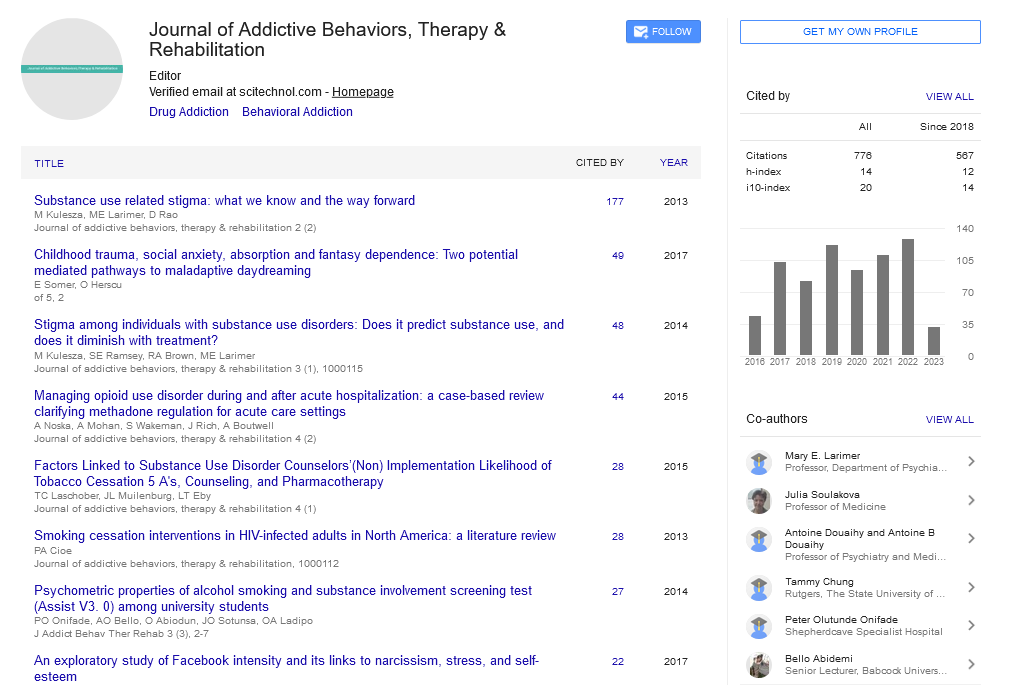Satisfaction of heroin-dependent patients with buprenorphine/naloxone maintenance treatment (B/NMT)
Jose Perez de los Cobos, Saul Alcaraz, Joan Trujols, Nuria Sinol, Oscar Lozano, Francisco Gonzalez-Saiz and Buprenorphine/Naloxone Survey Group
Sant Pau Biomedical Research Institute, Spain
Universidad de Cádiz, Spain
Unidad de Salud Mental Comunitaria Villamartín, Spain
: J Addict Behav Ther Rehabil
Abstract
This study aimed at assessing satisfaction of heroin-dependent patients with B/N as a medication and three other treatment interventions. Independent interviewers asked 316 heroin-dependent patients (Mage=44.0, SD=7.8; 80.4% males) from 16 Spanish treatment centres. Satisfaction with B/N was assessed using the scale to assess satisfaction with medications for addiction treatment–buprenorphine/naloxone for heroin addiction (SASMAT-BUNHER). Satisfaction with other treatment interventions was explored through specific single questions. Responses to these questions and all SASMAT-BUNHER items, except for those on the acceptability sub-scale, were given on a 5-point likert scale (1=terrible, 2=generally unsatisfactory, 3=mixed, 4=generally satisfactory, 5=excellent). SASMAT-BUNHER range scores were delimited as follows: 1–2 (very dissatisfied), >2–3 (slightly dissatisfied), >3–4 (slightly satisfied), and >4–5 (very satisfied). The current average dose of buprenorphine received by participants was 6.0 mg/d (S.D.=4.7). The overall SASMAT-BUNHER score (mean±S.D.) was 3.8±0.4. Regarding the SASMAT-BUNHER subscales, participants scored 3.6±0.5 on mental and physical State, 3.3±0.7 on anti-addictive effect on other substances, 4.0±0.7 on addictive effect of heroin, 4.2±0.7 on personal functioning, and 4.7±0.6 on acceptability. Moreover, most patients felt satisfied with the number of doctor’s visits (generally satisfactory=58.9%, excellent=25.0%) and urinalyses of opioid and non-opioid substances (generally satisfactory=41.5%, excellent=13.6%), as well as with the psychosocial interventions received (generally satisfactory=52.8%, excellent=14.6%). According to these results, Spanish patients felt slightly or very satisfied with different aspects of B/N as a medication and most of them were satisfied with three other key treatment interventions.
Biography
José Pérez de los Cobos received his MD in 1978 from the Universidad de Valencia and became a Psychiatry Specialist in 1984 under the Universidad de Alcalá de Henares, Hospital Ramón y Cajal (Madrid). In 1985, he obtained his PhD in Psychiatry by the same university. In 1990, he began working as a Psychiatrist at Hospital de la Santa Creu i Sant Pau, becoming the Head of its Drug Addiction Unit in 2001. He has also been Professor in Universidad de Alcalá de Henares from 1983 to 1989, and in the Universitat Autónoma de Barcelona, since 2001 to present. He combines his healthcare activity with the leadership of the Addictive Behaviours Research Group (IIB Sant Pau). His main areas of healthcare and research activity on opioid and cocaine dependence, focusing his lines of research on pharmacogenetics of methadone, satisfaction with treatment and cocaine craving.
 Spanish
Spanish  Chinese
Chinese  Russian
Russian  German
German  French
French  Japanese
Japanese  Portuguese
Portuguese  Hindi
Hindi 